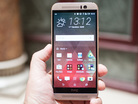Motorola Droid Turbo
Equipped with a high-capacity battery, a Snapdragon 805 processor, and a 21-megapixel camera, the Droid Turbo already has the workings of a solid device. But add a crisp 5.2-inch touchscreen with 565ppi and you have one of the most premium handsets around.
Equipped with a high-capacity battery, a Snapdragon 805 processor, and a 21-megapixel camera, the Droid Turbo already has the workings of a solid device. But add a crisp 5.2-inch touchscreen with 565ppi and you have one of the most premium handsets around.
Oppo Find 7
You might have never heard of the Find 7, but this smartphone from Chinese-based manufacturer Oppo has one of the most impressive displays we've seen. Packing 538ppi, it was one of the first globally available handsets with a 1,440p quad-HD panel.
You might have never heard of the Find 7, but this smartphone from Chinese-based manufacturer Oppo has one of the most impressive displays we've seen. Packing 538ppi, it was one of the first globally available handsets with a 1,440p quad-HD panel.
LG G3
With its 2,560x1,440-pixel resolution and a barely-there bezel, the 5.5-inch G3 gets major bragging rights. And while those specs may not be that discernible against its flagship competitors, or even to the human eye (which is only able to see about 466ppi), there's no denying that LG's marquee device is one sharp smartphone.
With its 2,560x1,440-pixel resolution and a barely-there bezel, the 5.5-inch G3 gets major bragging rights. And while those specs may not be that discernible against its flagship competitors, or even to the human eye (which is only able to see about 466ppi), there's no denying that LG's marquee device is one sharp smartphone.
Samsung Galaxy Note 4
Because the original Samsung Galaxy Note kicked off the era of big-screen smartphones, it's safe to expect every iteration after the first will sport a stunning and vivid display. The Note 4 is no exception, offering an expansive 5.7-inch quad-HD panel with a number of baked-in software goodies that work with the device's smart S Pen stylus.
Because the original Samsung Galaxy Note kicked off the era of big-screen smartphones, it's safe to expect every iteration after the first will sport a stunning and vivid display. The Note 4 is no exception, offering an expansive 5.7-inch quad-HD panel with a number of baked-in software goodies that work with the device's smart S Pen stylus.
Sony Xperia Z3
Having a 1,440p resolution isn't a requirement to land on this list. Case in point? The Xperia Z3. Its 1,080p display is punchy, sharp, and power efficient as well. Sony claims that compared to 2K screens, the Z3's is better for the battery. As such, the handset (which, we add, is also water-resistant) has a reported usage time of two days, and during our battery drain test for continuous video playback, it lasted an impressive 12.5 hours.
Having a 1,440p resolution isn't a requirement to land on this list. Case in point? The Xperia Z3. Its 1,080p display is punchy, sharp, and power efficient as well. Sony claims that compared to 2K screens, the Z3's is better for the battery. As such, the handset (which, we add, is also water-resistant) has a reported usage time of two days, and during our battery drain test for continuous video playback, it lasted an impressive 12.5 hours.
Google Nexus 6
Google dropped a big surprise when it announced its newest marquee handset would flaunt a huge 5.96-inch display. But whether or not the size is right for you, there's no denying it still has a great AMOLED screen. Featuring 493ppi, Android Lollipop 5.0, and a Snapdragon 805 CPU, the Nexus is one of the highest-end phablets on the market.
Google dropped a big surprise when it announced its newest marquee handset would flaunt a huge 5.96-inch display. But whether or not the size is right for you, there's no denying it still has a great AMOLED screen. Featuring 493ppi, Android Lollipop 5.0, and a Snapdragon 805 CPU, the Nexus is one of the highest-end phablets on the market.
Samsung Galaxy S5
Though Samsung cranked up the resolution for its Korean Galaxy S5 variant (in fact, it has an envelope-pushing 576ppi), the company still improved on its original Galaxy S5's 1080p screen. For one, it's equipped with a useful display panel and accompanying technology, which helps it to adapt to different lighting environments. The over-saturated tones that often plague AMOLED screen have also been toned down, leaving colors more realistic, but still striking.
Though Samsung cranked up the resolution for its Korean Galaxy S5 variant (in fact, it has an envelope-pushing 576ppi), the company still improved on its original Galaxy S5's 1080p screen. For one, it's equipped with a useful display panel and accompanying technology, which helps it to adapt to different lighting environments. The over-saturated tones that often plague AMOLED screen have also been toned down, leaving colors more realistic, but still striking.

















 RSS Feed
RSS Feed
